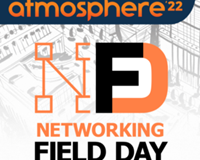
It’s impossible to talk technology today without acknowledging the world’s challenges that the industry is facing and Aruba Atmosphere ’22 is no exception. As we attempt to get “back to some sense of normalcy”, I reflect on the first in-person Atmosphere since shutdown and am struck at just how valuable the in-person experience is. There is no shortage of fun technical announcements this year ranging from network-as-a-service offerings to Aruba Central improvements under the NetConductor umbrella, to the thing that really resonated with me – self-locating APs.
While it was clear that we’re all out of “going to conferences” practice, it was obvious to me that the Aruba team has been working diligently behind the scenes for the past couple of years on making solutions to problems that we, as network operators, face daily. If you ask 10 different Wi-Fi professionals how to design, operate, and maintain a Wi-Fi network, you’ll get 15 different answers back, all with varying degrees of assurances, effort, and goals in mind. The most critical aspect of a Wi-Fi network is of course the placement of the APs in space, and opinions vary widely on things like post-implementation validations, ongoing assessment of your Wi-Fi network, and health checks. Aruba has taken the opportunity to work on a solution that promises to pay back dividends for your operational (or managed services) teams leveraging a unique approach to existing technology, in conjunction with some of the more recent IEEE innovations.
By mashing up traditional GPS technologies with Fine Time Measurements (FTM) that came by way of the 802.11mc rollup, Aruba plans to address more of the post-deployment Wi-Fi concerns around not only making sure that your operational teams have a precise understanding of where your assets are at in ceiling, but they also plan to use this as a framework for a more open conversation around how Aruba eventually hopes that the market will do client location applications in a more consistent and standard way – regardless of vendor. This takes a little unpacking – so be cautious about claims like “indoor GPS” – they’re likely to be fraught with complication and misunderstanding.
While GPS does play an important role in automatic AP location discovery, the GPS component of the solution is not like a navigation unit you may find in a vehicle or on your phone. The GPS being used in this situation is meant for a small number of APs to be anchor points, and FTM is meant to do the AP to AP sounding and distance measuring to a very high degree of fidelity. This creates a highly accurate (and continually self-updating) map of your infrastructure which ultimately drives things like understanding your client experience at any given location. It’s no longer enough for your infrastructure to tell you that the CEOs phone is having a bad time - but knowing with a high degree of confidence that it’s while your CEO is meeting with her team on the 14th floor conference room.
This fidelity plays a critical role in the operational maintenance of your Wi-Fi network and allows administrators (and of course automated, AI/ML driven management platforms) to respond proactively, tangibly and accurately to concerns that may arise (or reinforce that no problems exist). The operational benefits here are very straightforward, but the groundwork that it lays for what’s next is a great example of Aruba’s forward-looking initiatives that lay the groundwork today for improving end user experiences later. Imagine a world where app developers use a common way to consume location data from your Wi-Fi platform, regardless of infrastructure vendor. Reducing the app development friction between vendors has the potential to increase mobile device and app adoption in a more consistent way with a significantly better user experience, app to app. It’s great to see the trajectory Aruba is on here, addressing short term operational needs, while laying the groundwork for more tangible and consistent end user impacting features for future applications on infrastructure you’re deploying today.




